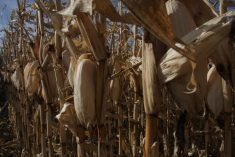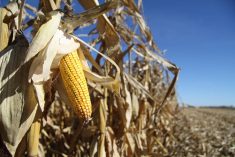Demand rationing needed now Arrival of new crop could hammer prices lower, says analyst
Informa Economics says farmers are about to enter a whiplash market, with corn prices likely to rise and then crash in the next six months.
“I kind of think, given the way this market is set up, we’re going to see both $7.50 to $8 corn and $4 corn between now and harvest,” executive vice-president Rick Andersen said in a presentation at Grainworld.
“We’ve got to get this old crop situation solved, then we can deal with new crop.”
Informa’s view is based on an assumption that corn supply will become extremely tight this spring and summer, followed by a large crop harvested in the fall.
Read Also

Prairies have variable soil moisture conditions
The dry weather in the west was welcome for preserving grain quality and advancing harvest, but it has resulted in very dry soil moisture conditions.
U.S. corn prices are important for prairie farmers because they set the foundation for North American feedgrains, including Canadian barley, and have a powerful influence on other cereals such as wheat. The prices of other crops are likely to follow if corn rallies and then slumps.
Andersen said for all the talk of demand destruction due to high corn prices late last summer and into the fall, there is little evidence that has occurred. World consumption is steady, with needs being met by winter exports from Brazil and Ukraine.
U.S. ethanol production hasn’t fallen enough to alleviate the tightness of U.S. corn stocks, and both the hog and chicken industries are chewing through feedgrain supplies with no signs of decline. Cattle numbers in feedlots are down, but apart from that, feed use is strong.
Andersen said it means the market will wake up at some point and realize the supply of old crop corn might actually run out before the new crop is harvested.
“The market has become very complacent,” said Andersen. “I think the market thinks the job is done. We believe that maybe we’re just right on the front end of actually having to see some major rationing of usage.”
The problem of getting corn out of Brazil is a nearby factor that could spur a rally in corn. With that country’s soybean harvest pouring into port, exporters have switched their focus from loading ships with corn to loading ships with soybeans. There isn’t capacity to do both, so Brazil’s corn exports will probably decline.
That is sending export demand back to the United States, further cutting into its stocks. Exports might eventually draw down remaining stocks to critical, unsustainable levels that provoke a fight over access to stocks.
“The buyers are going to have to come to the U.S., and we just may not have the corn to sell them,” said Andersen.
That’s the setup for a powerful rally in the months before the 2013-14 harvest, but Andersen said the market is likely to slump once newly harvested American corn is available.
He said the U.S. crop will be huge if farmers plant 97 million acres of corn and average weather follows it through the season and produces 160 bushels per acre.
“We get that, we solve the problem.”
That’s why Informa shares the low price projection for new crop corn put forward by the U.S. Department of Agriculture and other analysts.
The U.S. would be able to fully supply the domestic ethanol and feed industries, export aggressively and still have a two billion bushel, or 50 million tonne, carryover at the end of 2013-14 if it harvests a normal crop.
















